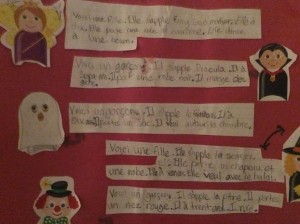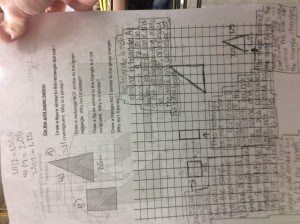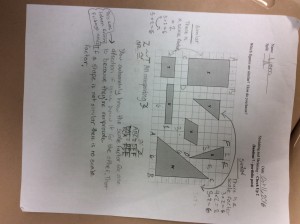Figures are mathematically similar if they have the same general shape. This trimester in math we have been learning about similar figures and what makes a figure similar. The very first rules of similar figures we learned, was that all corresponding angels are congruent for similar figures. This is just one of the many rules that make shapes similar. If the corresponding angels of two figures are congruent, that means that the angels are in the same position for the two figures. If you are looking at two triangles and you want to see if they are similar you can identify the corresponding angels and then check to see if they are congruent, or exactly the same. This is just one of the things to look at when identifying similar figures. you have to look at a group of rules to actually identify a figure similar, because a shape can have corresponding angels that are congruent, but not have the same general shape. If you are looking at a triangle and you think is similar to another triangle, you can find the scale factor. This means that you will look at two of the corresponding side lengths and divide one of the side lengths by the other. What you get is the scale factor, and from there you just have to multiply another side length by the scale factor and see if that is the answer to the other figures side length. You can also compare the ratios. When you compare the ratios you are simply seeing if a group of corresponding side lengths are divisible each other. Looking at the ratios is another way of looking at the scale factor. Any two rectangles are not similar, because while their corresponding side lengths are all congruent, there might not be a scale factor. Any two equilateral triangles are similar, because if you were to change the size in any way you would have to change it in every direction, so basically you would have to make each side length grow by the same amount, and it would be similar. Since every angel has to be similar, the side lengths have to match up in a certain place so that all the angels will all be the same. If only one side was to grow, the angels would change, and not all be the same.
 For my first project this year in digital art i was able to have full creative license. The assignment was to experiment with Photoshop and create a piece that incorporated grayscale, scaling, and a photo taken by myself. i started with my base image and went from there. My final project incorporated a black a white bomb in the background, a high quality image of me laying down, and a a scaled down version of a door and multiple birds. The project took about four classes and was an amazing entry into Photoshop. Having digital art this year is a great addition to art, and after having a few classes i wish we had been learning it for all of middle school. i am exited for the classes in digital art to come and happy that we finally are being taught it!
For my first project this year in digital art i was able to have full creative license. The assignment was to experiment with Photoshop and create a piece that incorporated grayscale, scaling, and a photo taken by myself. i started with my base image and went from there. My final project incorporated a black a white bomb in the background, a high quality image of me laying down, and a a scaled down version of a door and multiple birds. The project took about four classes and was an amazing entry into Photoshop. Having digital art this year is a great addition to art, and after having a few classes i wish we had been learning it for all of middle school. i am exited for the classes in digital art to come and happy that we finally are being taught it!



